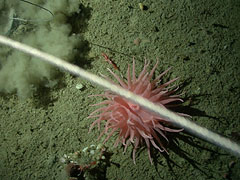

 | |||||||||||
|
|
Journals 2006/2007Miriam Sutton
August 11, 2006 AM Location: Makkovik Bank (55° 15' 03.20" N, 58° 14' 35.33" W) The scientists completed their bottom photography data collection today. The photos are observed by scientists to determine the type of seafloor sediment occurring in different offshore regions of Labrador's continental shelf and margin. The depth range of the seafloor the scientists were evaluating was between 125 and 350 meters deep. A deep water camera is mounted in a metal frame and is fitted with a triggering mechanism that causes the camera's light and shutter to fire once the camera is near the sea bottom. The camera is raised and lowered by a crane on the deck of the CCGS Hudson. (See Photo Equipment below.)
The triggering mechanism includes a weight that is suspended about 1 meter beneath the camera frame. This mechanism serves two purposes during the bottom photography collection: (1) an attached "pinger" provides communication to the ship that the camera is near the bottom, and (2) an attached "trigger" causes the flash and shutter to activate on the camera. When the weight strikes the bottom, the pinger turns off its sound and a flash and the shutter is fired. The crane operator winches the camera a few meters back toward the surface which gives the flash time to recharge. He then lowers the camera to the sea bottom again. Each time the crane operator lowers the camera frame, the suspended weight strikes the bottom, the pinger signal stops and the camera is triggered again to fire and take another photo. (See Camera Weight with Soft Coral photo below.) The scientists shoot between 6 and 10 photos at each site. When the camera returns to the surface, the images are downloaded and evaluated to determine the type of seafloor sediment. The camera also captures images of a variety of benthic species that may live along the sediment; including soft corals, urchins, sea stars, and anemones. (See Weight Triggering photo below.)
Today's activity: Scientists often use the metric system to generate more accurate measurements in their data collection. If one meter is equal to just over three feet, use your estimation skills to determine the depth of the sea bottom during today's research. Based on your depth estimation, why do you think scientists needed to trigger a flash on their camera? Word of the Day: Benthic (or benthos) organisms REMINDER: Record today's Sea Surface Temperature (SST) and the Air Temperature on the data table you created from the August 05 journal entry. |
||||||||||

